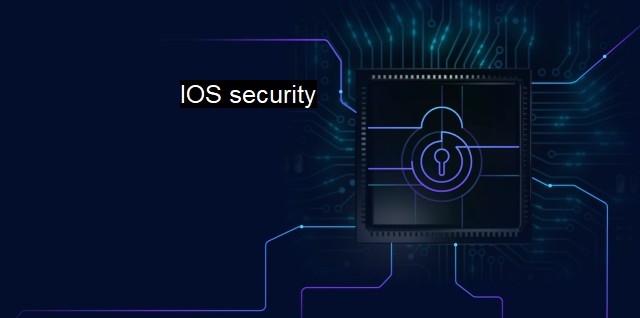What is IOS security?
The Importance of IOS Security in Protecting Personal Information: Encryption, Password Protection and More
IOS security refers to the measures taken to guard Apple devices such as iPhones and iPads and their operating systems against digital threats. With an uptick in cybersecurity threats, protecting IOS platforms takes on critical importance in ensuring the safety of private information stored on Apple’s devices.Apple’s IOS security fragment contains an array of safeguards specifically designed to adequately shield systems and stored data from malevolent threats, including malware and spyware, even if they bypass other key security features. This fundamental provision encompasses several iOS security layers, escalating the level of difficulty for cyber intruders to crack the systems.
Apple espouses a design approach that maximizes security by managing features and applications in a constrained environment, prioritizing minimal data exposure to potential threats. The nucleus of the iOS security model is the process of user confirmation for security-sensitive tasks to constitute a 'sandbox' catch-all for applications, where apps can only alter their domain and not the device or other apps.
Apple's implementation of data-in-transit protection is part of their commitment to iOS security. Here, cryptographically strong encryption shields data packets pandering across a network, thus leaving little margin for cyber intruders to intercept potentially sensitive data in transit. With industry-leading protocols like Internet Protocol Security (IPSec) and Secure Socket Layer (SSL) Transportation Layer Security (TLS) acting as the security bulwark here, leveraging best of breed cryptographic algorithms enhanced security measures even further.
It's worth mentioning Apple's exploit mitigations strategy as a part of their iOS security. Runtime process security is a distinctive feature in iOS which stands as an additional layer of Apple's security measures. It involves implementing several techniques such as Address Space Layout Randomization (ASLR), making it onerous for adversaries to predict the system's reaction to a rogue action.
Despite advancements in security protocols, new and complex malware attacks are gradually evolving and becoming more difficult to intercept and prevent. As a result, antivirus applications have increasingly become more salient in buttressing the device's security.
Antiviruses designed for iOS perform an applaudable task in identifying and neutralizing malicious software lurking within the digital pathways to predispose unforeseen threats to the device. This further elevates safety level by constantly examining the activities of applications installed on the device. The user is alerted anytime the antivirus perceives risky behavior or attempts to initiate unauthorized operations.
The antivirus also manages web navigation safety by thwarting access to malignant websites that could potentially contain malicious content. This significantly reduces the odds of an attack and if in event of one, the antivirus isolates the threat and addresses it without allowing influence on the other elements of the device.
Apple has put in the conscious effort to diligently follow a model where security upgrades occur along with OS updates, providing users with the most evolved security features timely.
The inclusion of biometric systems, Face ID and Touch ID prominently up the security bar too. This novel form of authentication is implemented by necessitating users to supply their facial or fingerprint data to access the device or specific applications. Thus, it intensely safeguards both hardware and software from unauthorized access.
Apart, devices’ data is encrypted with a unique code particularly associated with the user's passcode. Unless a correct passcode is entered, the user's information remains in an unreadable state, fostering improved security.
iOS security encompasses an extensive range of strategies that device manufacturers implement to protect devices and their systems safeguarded against potential security threats. Though iOS devices come with an inherent security layering, additions like antivirus applications bolster device’s immunity against malware attacks. Thus rendering the formidable task of infiltrating iOS devices far more challenging.

IOS security FAQs
What is iOS security?
iOS security refers to the measures put in place to protect the operating system of Apple devices against cyber attacks and unauthorized access. It encompasses various protocols, technologies, and applications designed to ensure the confidentiality, integrity, and availability of data stored or transmitted on iOS devices.What are some of the security features in iOS?
Some of the security features in iOS include biometric authentication, security tokens, password protection, app sandboxing, and encryption. iOS also includes a secure boot process, which checks the integrity of the operating system at startup, and continuously monitors for any signs of tampering or malware infection.How does iOS protect against viruses and malware?
iOS protects against viruses and malware by implementing a sandboxing approach, which isolates apps from one another and from the core operating system. This means that even if an app is infected with malware, it cannot spread to other apps or compromise the entire system. Additionally, iOS automatically scans apps for known malware before allowing them to be installed.Is jailbreaking an iOS device a security risk?
Yes, jailbreaking an iOS device can pose a significant security risk. By jailbreaking a device, the user bypasses the built-in security measures implemented by Apple, making the device more vulnerable to malware and other cyber threats. Jailbreaking also exposes the user to fraudulent apps and services, which can steal personal data or compromise the device's operating system.| | A | | | B | | | C | | | D | | | E | | | F | | | G | | | H | | | I | | | J | | | K | | | L | | | M | |
| | N | | | O | | | P | | | Q | | | R | | | S | | | T | | | U | | | V | | | W | | | X | | | Y | | | Z | |
| | 1 | | | 2 | | | 3 | | | 4 | | | 7 | | | 8 | | |||||||